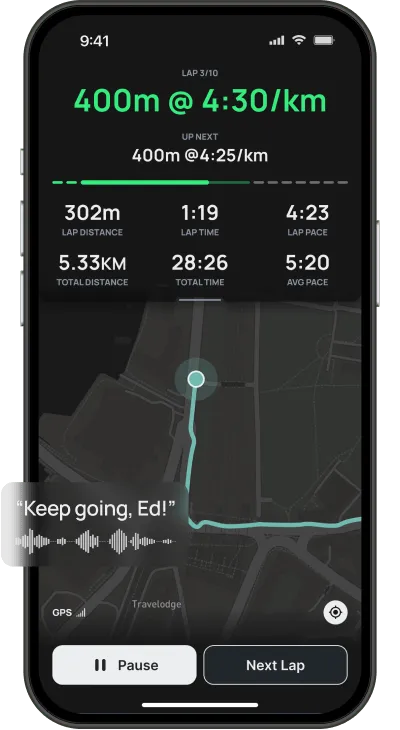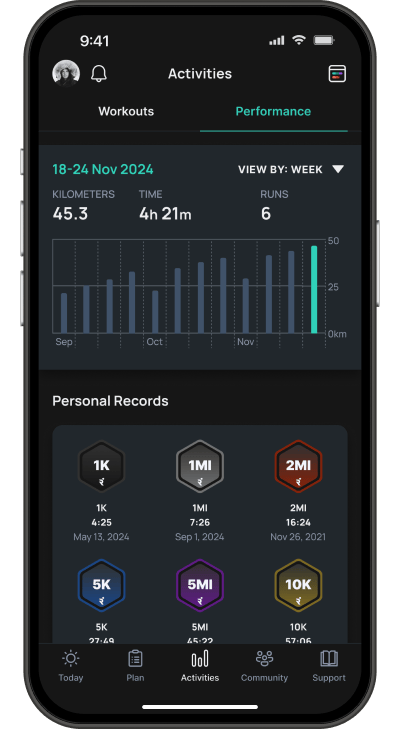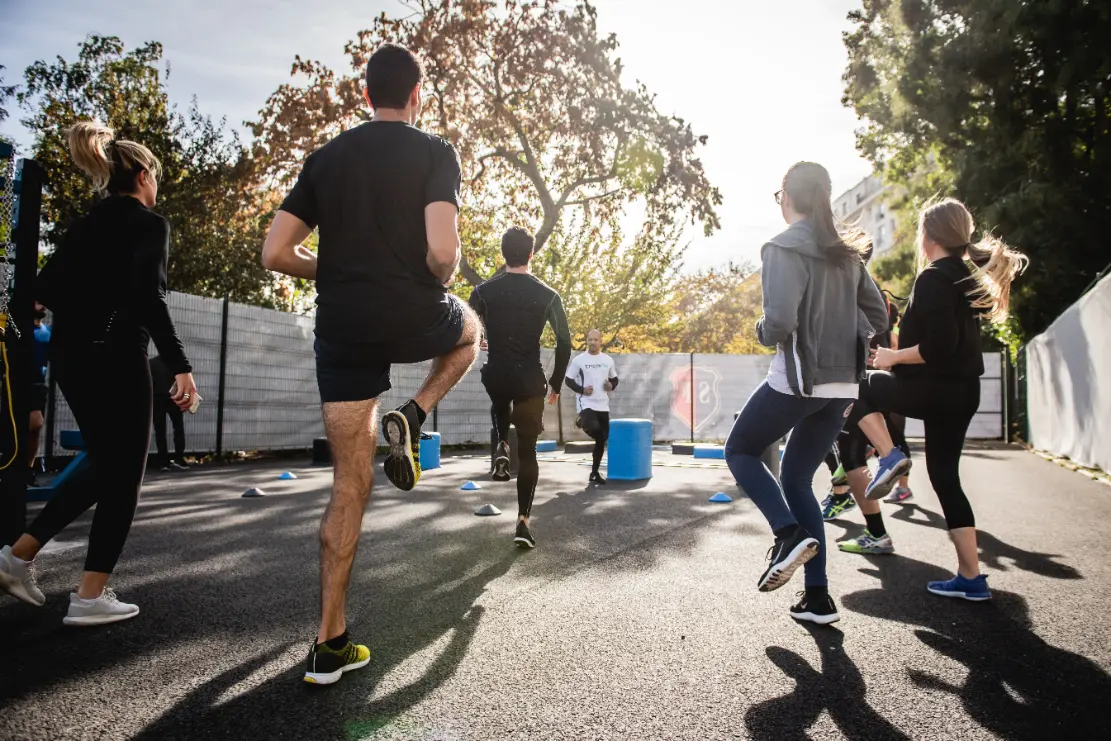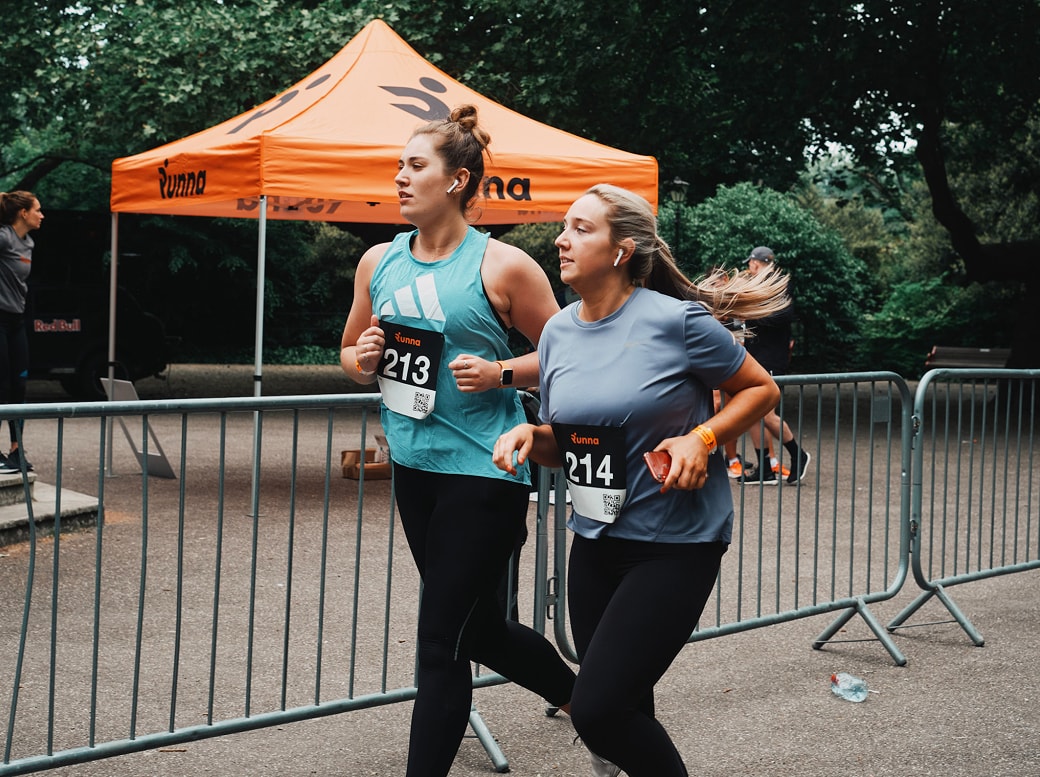Post-injury Running Training Plan
The road back from injury can feel uncertain, but it doesn’t have to. With the right post-injury plan, you’ll recover steadily, avoid setbacks, and find your stride again with confidence.

How to return to running after an injury
Coming back from injury is one of the hardest - and most important - parts of a runner’s journey. The urge to jump straight back into training is strong, but the smartest approach is gradual, structured, and focused on protecting your body for the long term.
The first step is always clearance: make sure you’ve had the green light from a doctor or physio, especially after major injuries. From there, the focus shifts to building back steadily. That means starting small, testing your readiness with simple walk-run sessions, and only adding distance or intensity when your body feels comfortable. Progress should feel measured, not rushed.
Consistency matters more than speed of progress. Add your sessions to your calendar to make running part of your routine again, and consider keeping things social - whether that’s joining a club, running with a friend, or finding an accountability partner. Beyond running, cross-training, mobility, and strength work are invaluable tools to restore balance and protect against reinjury.
Think of this phase as rebuilding your foundation. Every careful step forward helps restore confidence, resilience, and enjoyment in your running. With the right plan and a little patience, you won’t just return - you’ll come back stronger.

Why choose our post-injury training plan?
Whatever your injury history or running background, we’ll ensure you return safely and confidently.
How to get started
Runna takes the guesswork out of returning from injury. From your first cautious steps to running consistently again, you’ll know exactly what to do and when to do it.
Choose your plan
Tell us about your injury history, current fitness, and weekly availability - we’ll create a plan that is tailored to your needs.
Download the app
Download the app, log in, and you’ll have your full training plan - complete with runs, tips, and guidance - at your fingertips.
Run, run, run!
Simply tap ‘Go’ and follow along. Every run is laid out clearly, so you always know exactly what to do.
Hit that goal
Stick with your plan and you’ll come back stronger with restored fitness, renewed confidence, and the resilience to keep running long-term.
Workouts explained
Your post-injury training includes a mix of sessions - each with a clear purpose. Here’s what they are and how they’ll help you ease back into your running journey.
Tips for your post-injury training plan
These expert-backed tips will help you rebuild confidence, avoid setbacks, and stay motivated. From pacing and recovery to strength and mindset, discover a small glimpse of the guidance and support you’ll have at your fingertips with our post-injury training plan.
Nutrition
When you're returning from injury, what you eat directly influences how quickly tissues heal, how much energy you have for sessions, and how resilient you feel day to day.
- Protein is the cornerstone of recovery. Aim to include a source like lean meat, fish, eggs, dairy, beans, or lentils at every meal. This supports muscle repair, tendon and ligament health, and helps limit the loss of strength during time off.
- Carbohydrates provide the energy you need to train without dipping into fatigue. Complex carbs such as oats, quinoa, whole grains, and starchy veg keep energy steady, while a small portion of quick carbs (like a banana or slice of toast) before a run can give an immediate boost.
- Healthy fats from avocado, nuts, seeds, and olive oil support hormone function, joint health, and help regulate inflammation - all crucial after injury.
- Hydration is often overlooked but vital. Dehydration slows recovery, reduces muscle efficiency, and increases soreness. Sip water consistently through the day rather than only around workouts.
Supplements aren’t essential, but some runners benefit from vitamin D, omega-3s, or collagen - especially if recommended by a healthcare professional.
Think of your diet as part of the recovery plan. Hitting these basics ensures your body has what it needs to come back stronger.

Cross-training and strength training
Coming back from injury isn’t just about running again - it’s about rebuilding a stronger, more resilient body. Cross-training and strength training are the two most powerful tools to support that process.
Cross-training allows you to stay active and improve cardiovascular fitness without the repetitive impact of running. Low-impact options like swimming, cycling, rowing, or using the elliptical give your joints and healing tissues a break while still training your aerobic system. These sessions are especially useful on days when running isn’t yet comfortable, or if you need to reduce weekly impact while staying consistent.
Strength training is one of the most effective ways to support a safe return. By rebuilding strength in your glutes, hamstrings, calves, quads, and core, you improve stability, absorb impact more effectively, and correct imbalances that may have contributed to your injury in the first place. Even 1–2 short sessions per week can help reduce re-injury risk and restore confidence in your movement.
With Runna, your post-injury plan integrates tailored strength sessions and low-impact cross-training, ensuring your comeback is structured, balanced, and sustainable.

Pacing
After injury, pacing isn’t about chasing speed - it’s about control. The goal is to run at efforts that feel manageable, protect your body, and gradually rebuild confidence. Think of pacing as listening to your body first, numbers second.
In the early stages, most sessions will be easy or walk-run intervals. These allow your muscles, joints, and tendons to re-adapt to impact without overload. As you progress, the ratio of running to walking increases, and your body relearns how to handle sustained effort.
Effort-based pacing is key:
- Easy runs should feel conversational, at a 3–4 out of 10 effort.
- Progressive runs may add short, slightly harder efforts (5–6 out of 10), but never to the point of pain or excessive fatigue.
- Strides or light pickups might be introduced later to reintroduce faster turnover - but only once you’ve rebuilt a solid base.
With Runna, your sessions are structured so you always know when to hold back, when to push, and how to progress safely without risking setbacks.

Form
After an injury, running form becomes even more important. Moving efficiently not only helps you feel smoother but also reduces the load on healing tissues and lowers the risk of setbacks.
Efficient form will:
- Minimize unnecessary impact on joints and muscles.
- Reduce the energy cost of each step, so runs feel more sustainable.
- Support injury prevention by reinforcing strong, balanced movement patterns.
Key things to focus on as you return:
- Run tall with relaxed shoulders to keep posture strong and stable.
- Short, light strides reduce stress on joints compared to overstriding.
- Drive arms rhythmically, letting them guide forward momentum without tension.
- Stay relaxed through your face, jaw, and hands to avoid wasting energy.
Think of this stage as a refresher, not a full reset. Your body already has the muscle memory - you’re simply rebuilding good habits. Start by picking one cue to focus on per run, like landing softly or keeping cadence quick, and let these small improvements stack up over time.
Remember: Good form isn’t about perfection. It’s about making each step safer, smoother, and more confident as you return to consistent running.

Recovery
Recovery is the foundation of rebuilding after an injury. Training only makes you stronger if your body has enough time to adapt, so prioritizing rest is incredibly important.
Here are the key things to focus on:
- Sleep: Aim for 7–9 hours each night. This is when tissues repair, inflammation reduces, and your body adapts to the new training load.
- Mobility work: Gentle yoga, Pilates, or targeted stretching can restore flexibility and relieve stiffness that often lingers after injury.
- Massage and tools: Foam rolling, massage guns, or occasional sports massage improve circulation and ease tight muscles around the previously injured area.
- Nutrition and hydration: Refuel with protein to support tissue repair and carbs to restore energy stores. Staying hydrated keeps recovery on track and supports joint health.
- Active recovery: Low-impact movement - like walking, swimming, or cycling - boosts blood flow without adding stress, helping your body bounce back between sessions.
- Flexibility: Listen to your body. If soreness feels sharper than usual or if old pain starts to return, ease off. Taking an extra rest day now is far better than risking another setback.
Remember: Treat recovery as part of your training.

Gear
The gear you use while returning from injury can make a huge difference in both comfort and confidence.
- Shoes: Invest in a well-cushioned, supportive pair that matches your stride. If your old shoes are worn down, replacing them is especially important to reduce impact and protect joints. A gait analysis at a running store can help you find the right fit for injury prevention.
- Clothing: Technical fabrics like polyester or nylon wick sweat, reduce chafing, and regulate temperature, keeping you comfortable even on easier comeback runs.
- Running watch or GPS tracker: Tracking distance and effort is valuable when returning post-injury. Monitoring progress helps ensure you’re building up gradually without overdoing it. Runna integrates seamlessly with Garmin, Apple Watch, COROS, and Strava to keep you on track.
- Accessories: Simple tools like belts or armbands can keep essentials close at hand, while lightweight hydration bottles or packs are useful if you’re adding time back into your routine.
- Support gear: Items like compression sleeves, insoles, or braces can sometimes help provide stability or reduce discomfort in previously injured areas - but always test them in training before relying on them.
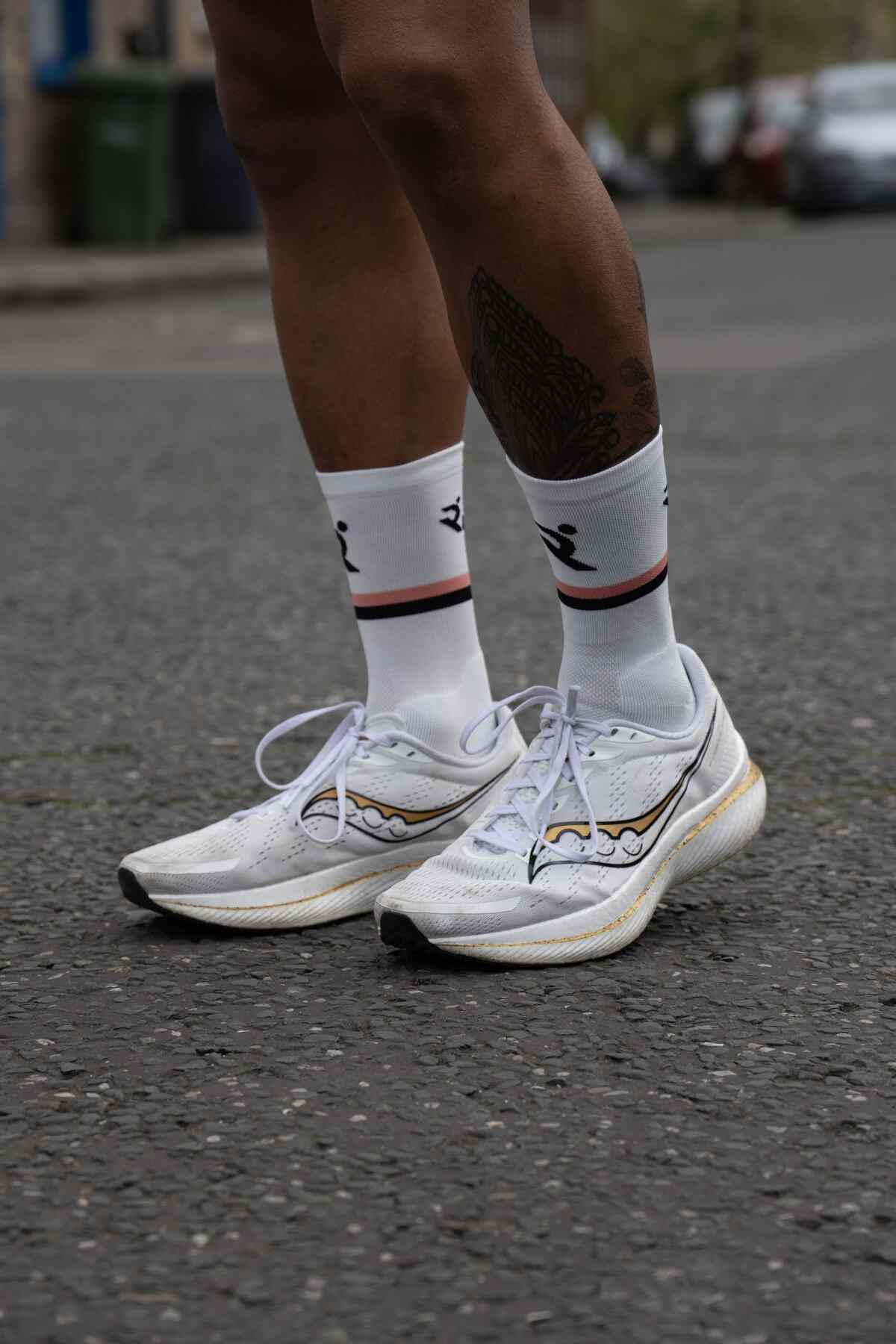
As featured in




Stories from Runnas
FAQ: All you need to know about running post-injury
When can I start running again after an injury?
This entirely depends on the type of injury and the affected area. Your doctor will guide you through the recovery process and give you an approximate timeline; make sure you check in with them before you get back to running, especially after more serious injuries.
To check if you’re ready, you can do a one-minute jog test and a 30-seconds hop test on the affected limb. The next step is to do a test run of 10 minutes split in chunks of 2 minutes with one minute walking rest in between.
If all is well, you can then begin a post-injury training plan to get back to running safely.
How long will it take to rebuild my endurance?
The time it’ll take you to rebuild your endurance and get back to your previous running performance depends on the time you needed to recover from the injury.
If it’s only a minor injury or niggles that put your training on pause for a couple of days, you’re unlikely to have lost any fitness – on the contrary, sometimes taking breaks can actually be beneficial for your performance, especially after periods of particularly strenuous training.
If you suffered a more significant injury, setting you back a few weeks or months, you’ll inevitably experience some loss in endurance and fitness. The best way to mitigate this is to engage in cross-training and strength training while you recover, and try to stay as active as possible.
With patience and consistency, you’ll be able to rebuild your running endurance from before the injury without problem.
Which training plan should I pick after I finish the post-injury one?
Pick a plan that matches your goals and schedule. If you’re feeling in good shape and there’s no signs of your injury flaring up, you can start training towards a specific goal.
If you haven’t decided on your next goal yet, you can simply use our 12 week maintenance running plan.
How many times a week should I run?
If you’re returning to running after a break or an injury, start with one or two running sessions per week before you increase the number of days you run. You can use our post-injury training plan to transition from post-injury recovery to rebuilding your running fitness safely.
How do I prevent injuries in the future?
Strength conditioning is one of the best ways to prevent injuries, since it prepares your body to absorb higher loads and helps improve your running economy.
Additionally, make sure your running form is on point; a bad running technique will leave you vulnerable to injuries. Find out more about how to improve your running form.
Sufficient rest and fueling your runs and recovery adequately are also key. As far as nutrition is concerned, protein is essential for helping your body recover and build strength, along with a healthy diet low in sugar and processed foods.
How can I transition from post-injury running to training for a goal?
Our post-injury training plan will help you get back to running safely, by enabling you to progressively build your strength and endurance.
Once you start regaining confidence in your running ability, you can start thinking about the next goal you want to train for – or you can use our maintenance plan before that. Listen to your body and allow for additional training and recovery time as needed.
Once you’re feeling ready, you can simply switch plans. With Runna, you can get personalized training plans for every goal out there, from 5k to 250k.
Inspiration

Returning to Running Post-Injury
Once your injury has subsided and you're returning to full-strength, check our progressive list of exercises to return to running.

Choosing Your Running Ability After Injury
You're ready to start our post-injury plan but you aren't quite sure where to start. We have some guidance to help you!

Top Tips for Returning to Running After a Break
Getting back into running after a long break can be challenging, but we're here to help. Here are our top tips.



